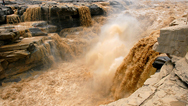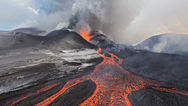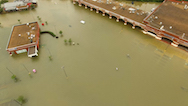First Time Britain Left Europe
- By Drew Gannon
- Posted 12.06.17
- NOVA
Transcript
First Time Britain Left Europe
Published December 6, 2017
Narrator: The English Channel. It links the North Sea in the east to the Atlantic Ocean in the west. it’s the busiest shipping lane in the world. And towering more than three hundred and fifty feet above it, on the south coast of England, are the White Cliffs of Dover. Geologists, like James Lawrence, now think these iconic chalk cliffs hold an extraordinary secret.
James Lawrence: People don’t realize that if I was to go over to France, we could find similar chalk cliffs. We are getting exactly the same rocks which have been deposited in exactly the same environment on this side of the Channel, and on the French side of the Channel.
Narrator: And James’ discovering that the connection between the cliffs in France and England goes beyond the chalk itself. Embedded in the white chalk are a series of horizontal bands of a dark rock called flint.
Lawrence: Here I have a fantastic band of flint.
Narrator: Flint, a form of the mineral quartz, is formed by changes in ocean chemistry. But these changes occur only occasionally, resulting in these distinctive dark bands.
Lawrence: These flint bands are continuous throughout the chalk.
Narrator: This band of flint runs through the entire cliff, and there are dozens running horizontally, each one at a different level in the chalk. Taken together, these parallel bands of dark flint form a unique geological fingerprint in the white cliff. What’s extraordinary is that the same geological fingerprint is visible on the other side of the Channel.
Lawrence: So the chalk and the flint in these cliffs forms a bar code and is exactly the same as the chalk and the flint in the cliffs in France.
Narrator: The spacing and levels of the flint layers perfectly align.
Lawrence: So what we know from this evidence is that a chalk ridge once connected England and France.
Narrator: These flint layers tell us that hundreds of thousands of years ago, a ridge of chalk almost seven miles wide once extended twenty one miles across the Channel, joining what is now Britain to the European Continent. But this discovery raises a brand new mystery.
Lawrence: Somehow, the cliffs between England and France have been separated over time.
Narrator: If Britain and France were once joined, what force separated them and turned Britain into an island?
Credits
PRODUCTION CREDITS
- Digital Editor
- Drew Gannon
- Killer Floods
- Filmed and Directed by
- Elliot Kew
- Edited by
- Felix Black
- Ben Lavington Martin
FOOTAGE AND GRAPHICS
- Visuals
- Getty
ShutterStock - Music
- APM
SFX
Related Links
-

Killer Floods
Discover how colossal floods transformed the ancient landscape.
-

Killer Hurricanes
Experts reconstruct the Great Hurricane of 1780 to help predict the risk of future storms.
-

Killer Volcanoes
Scientists hunt for a mega-eruption that plunged medieval Earth into a deep freeze.
-

Why Did Houston Flood?
Hurricane Harvey broke continental U.S. records. Here's how cities can be better prepared.

